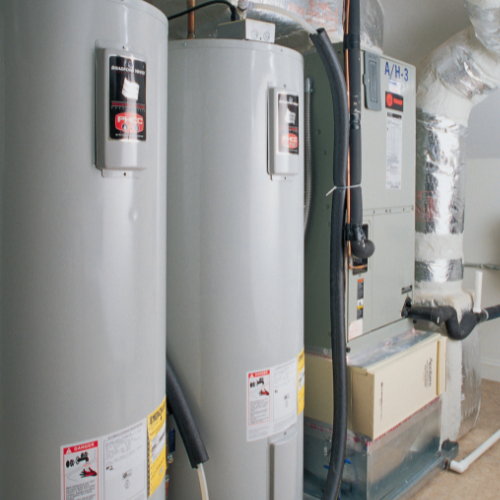How to Properly Flush Your Water Heater
A well-maintained water heater can provide years of reliable service, but over time, sediment and mineral buildup can reduce its efficiency and lifespan. Flushing your water heater is an essential maintenance task that can help keep it running smoothly and efficiently. In this guide, we’ll walk you through the process of properly flushing your water heater to improve performance and prevent costly repairs.
Why Is Flushing Important?
Over time, minerals like calcium and magnesium from hard water settle at the bottom of your water heater tank. This sediment buildup can:
Reduce heating efficiency: The sediment acts as an insulator, making it harder for the heating element or burner to heat the water effectively.
Cause overheating: When sediment builds up too much, it can cause the water heater to overheat, which can damage the tank or heating elements.
Shorten the lifespan of your water heater: Sediment buildup can lead to corrosion and even leaks, drastically reducing the lifespan of your unit.
Increase energy costs: A water heater that’s working harder to heat water uses more energy, leading to higher utility bills.
Flushing your water heater once a year (or more often if you have very hard water) can help avoid these issues, ensuring that your water heater runs at peak efficiency for longer.
How Often Should You Flush Your Water Heater?
The frequency of flushing depends on the hardness of your water and how much sediment builds up. For most homes with average water quality, once a year is sufficient. However, if you have hard water, you might need to flush your tank every six months to prevent heavy sediment accumulation.
Tools and Materials You’ll Need
Before starting, make sure you have these items on hand:
A garden hose
A large bucket or drain pan (optional, depending on where you’ll drain the water)
A screwdriver (for older models)
Towels for cleanup
Steps to Properly Flush Your Water Heater
Step 1: Turn Off the Power and Water Supply
electric water heaters:
Turn off the power at the circuit breaker to prevent any electrical hazards.
Wait for the water in the tank to cool down for safety.
gas water heaters:
Turn off the gas supply to the unit.
Wait for the water to cool down.
Next, turn off the cold water supply valve to the water heater. This will prevent more water from entering the tank while you’re draining it.
Step 2: Attach a Hose to the Drain Valve
Locate the drain valve at the bottom of your water heater. Attach a garden hose to the valve and run the hose to a floor drain, a sink, or outside where the hot water can be safely drained.
Step 3: Open the Pressure Relief Valve
To ensure proper drainage, open the pressure relief valve (a small lever or valve located near the top of the tank). This will allow air to enter the tank and help the water drain more smoothly.
Step 4: Drain the Tank
Open the drain valve on the bottom of the tank and allow the water to flow out. Depending on how much sediment has accumulated, the water may appear cloudy or contain bits of debris. You may need to let the water run for 10-20 minutes until the water runs clear.
Step 5: Flush the Tank
Once the tank has drained, close the drain valve. Now, you’ll want to flush the tank to remove any remaining sediment.
Turn on the cold water supply valve to the water heater. Let the water run into the tank, but only for a short time. This will stir up the remaining sediment and help flush it out of the tank.
Open the drain valve again and allow the sediment-laden water to flow out. Repeat this process until the water draining from the tank runs clear, indicating that all the sediment has been flushed out.
If you notice a lot of built up gunk on the side of the tank or on the tank elements you may have to descale the tank itself. This process is usually done by a professional as it can be a complex process and if the necessary steps aren’t taken then you may damage components. Contact a professional in water heater repair if you aren’t certain how to descale your water heater.
Step 7: Refill and Power Up the Heater
Once you’ve finished flushing and descaling the tank, close the drain valve and disconnect the hose. Turn on the cold water supply and allow the tank to fill up completely. Check the drain valve to make sure it’s properly closed.
For electric water heaters, turn the power back on at the circuit breaker. For gas water heaters, turn the gas back on and relight the pilot light if necessary.
Step 8: Check for Leaks and Test the Heater
After everything is reconnected, check the drain valve for leaks and ensure the water heater is operating correctly. Turn on the hot water faucet and allow the system to heat the water. It may take a little time for the water to reach the desired temperature, but once it does, check the flow and temperature to ensure everything is working properly.
Tips for Maintaining Your Water Heater
Install a water softener: If you have hard water, installing a water softener can reduce the amount of mineral buildup in your water heater.
Check the anode rod: The anode rod helps prevent corrosion in your water heater tank. Check it annually and replace it if necessary.
Keep the area clean: Ensure that the area around your water heater is free from dust and debris, as these can affect the unit’s performance.
Final Thoughts
Flushing your water heater is a simple yet essential maintenance task that can improve efficiency, extend the life of the unit, and help you avoid costly repairs. By following these steps, you can ensure that your water heater runs smoothly and efficiently for years to come. Regular maintenance can also improve water quality and reduce energy bills, making it well worth the effort.
If you’re unsure about performing these tasks yourself, or if you encounter problems, it’s always a good idea to call a professional plumber to assist with the process.

